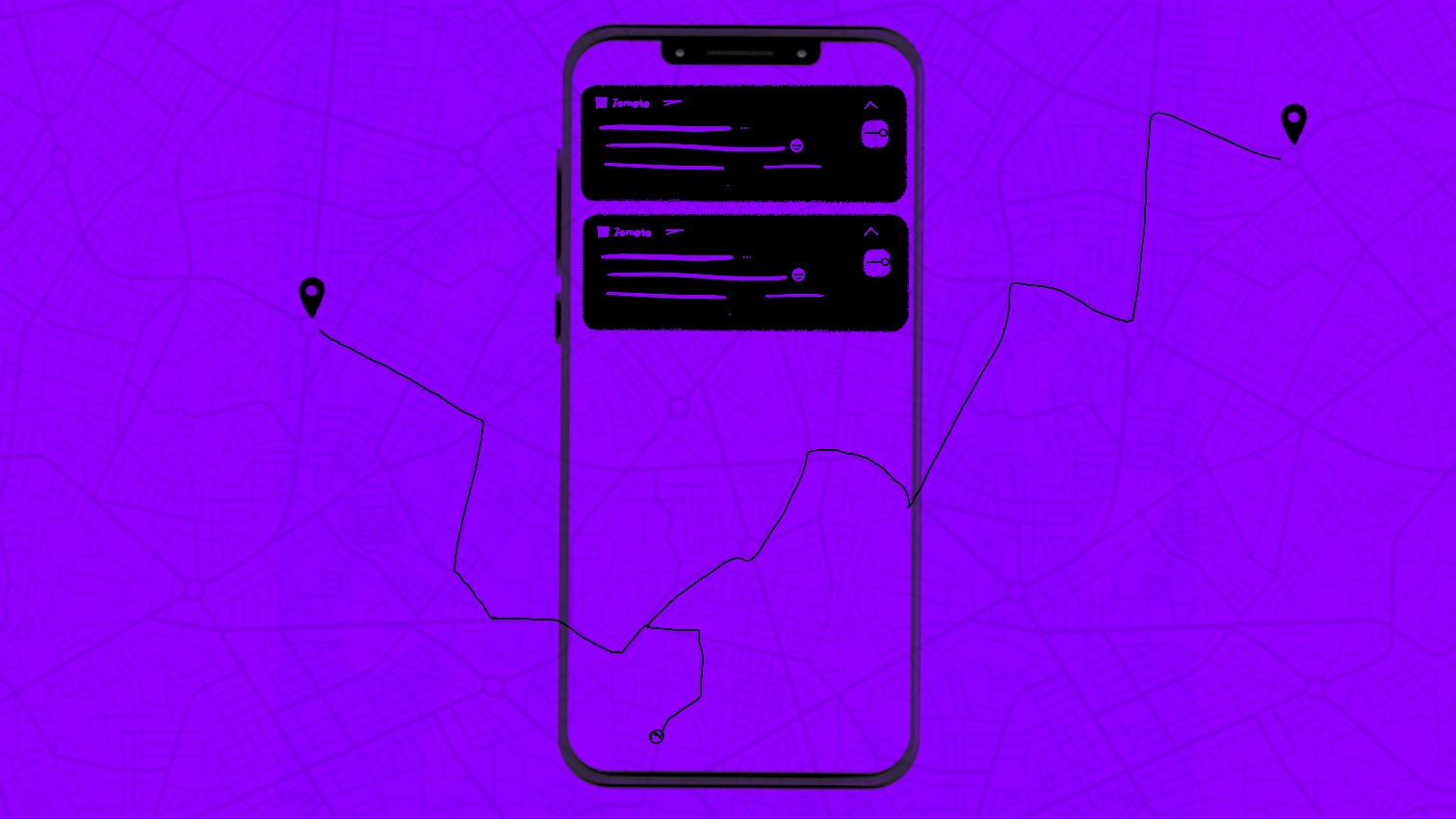After a long day, when you come back home, all you really want is good food.
Now, a decade ago, you'd have to call up that one Chinese shop on your street to order the same thing 3 times a week. But, thanks to food delivery startups, things have changed.
The convenience of just logging into Zomato, tapping a few times and having food appear on your doorstep cannot be understated.
Zomato made INR 4192 Cr in revenue in FY22, for offering that convenience. But, the story doesn't just end with a great product.
The groundbreaking shift of users towards online food delivery is partly thanks to Zomato's subtle but effective marketing strategy.
So, let's learn about the Zomato marketing strategy & their famous growth hacks!
Firstly, a bit of backstory: How did Zomato come to be?
Zomato was founded by 2 IIT Delhi graduates, Deepinder Goyal and Pankaj Chaddah. But, it was not the first taste of entrepreneurship for Deepinder in the food industry.
All the way back in 2005, Deepinder, straight out of IIT Delhi, had attempted to buildd a food delivery startup called foodlet.com. But, this startup didn't take off like its later version.
Why you ask? Well, Deepinder was too early to the game.
But, a second opportunity appeared, while the duo was working at Bain & Company.
The story goes something like this — Deepinder's colleagues would always complain about all the leaflets they had to manage for different restaurants. This was back in 2008 when restaurants got new customers by distributing physical leaflets with printed menus and contact details.
Deepinder and Pankaj took it upon themselves to solve this problem. They created "Foodiebay" — a restaurant discovery platform which consolidated all the food menus & details of restaurants. So, users could discover new places and leave authentic reviews and ratings for other customers.
Foodiebay was quickly growing with 8000 restaurants and over 2M users. But, in 2010, Foodiebay was rebranded to Zomato. Later in 2015, they decided to incorporate the food delivery service.
Long story short, you know how it turned out. Zomato expanded to a $5.5B valuation, generated a revenue of $525M in FY22 & went public with a $1.1B IPO!
But, how does Zomato make money?
Now, to understand Zomato's marketing goals, you'd first have to understand how Zomato makes money.

Let's start with the different wings of this company. Zomato essentially has 4 main wings:
- Food delivery ➝ Zomato delivers food to customers
- Dining out ➝ Users can discover restaurants, look through their menus and book tables via Zomato
- Materials supply business to restaurants ➝ Zomato provides raw materials to restaurants
- Zomato Pro ➝ The premium subscription that comes with very high discounts
Now, apart from the raw material supply side of its business, the other 3 wings are built on the backbone of its database of restaurants.
Here's how it makes money through them:
- Zomato charges a commission of 7% of the total order value, along with delivery and payment gateway charges. Some restaurants also have to pay a platform fee of INR 99.
- Apart from this, Zomato makes money through its ad network. Restaurants can pay to get better placements of their ads on the platform which will drive more users. Dining out is essentially also monetized through advertisements — which account for 70% of its revenue.
- Finally Zomato Pro, the paid membership, generates part of its revenue.
So, essentially Zomato's money-making prowess depends on the number of people who visit their website & app and decide to order food.
Zomato Marketing Strategy: Their best growth hacks!
Now, we know Zomato has ONE goal — to drive users to Zomato's website & eventually the app. And, later on, nudge them towards periodic food orders.
This is accomplished by the different Zomato marketing strategies. So, let's dive in!
1) SEO
Now, Zomato's primary goal is to get users who:
a) will possibly order food online
b) are looking for restaurant reviews, menus, ratings and other details
Zomato finds both sets of these users on Google. So, it won't be an overstatement to say that SEO is Zomato's most important marketing channel!
In fact, if we were to quantify this — over 61% of Zomato's users arrive at its website via Google search. That's 30M+ monthly visits!
One of the reasons why Zomato rules the food & restaurant-related searches is because of its original restaurant discovery site structure.
Structure:
City Subfolder ⇒ Restraunt-name ⇒ Location-name ⇒ Review / Order / Menu / Photos pages
I have written in detail about this in a 2 part article series about Zomato's SEO strategy (Part1 / Part 2).
But, today let's explore a different strategy.
Targeting "near me" type keywords
Now, apart from the usual restaurant pages, Zomato also has a bunch of pages that target very specific keywords. These keywords are called the "near-me" type keywords.
.jpg)
For example:
- restaurant nearby — 20.3M
- bakery near me — 1.3M
- coffee near me — 243K
- bars near me — 3.5M
- deserts near me — 2.1M
1) Zomato has ~500 pages targeting different variations of this keyword
2) They collectively bring Zomato 2.5M monthly traffic
3) These keywords very significantly contribute to Zomato's overseas revenue. They bring in 320K total traffic from the United States alone!
But, how is Zomato able to rank for these high volume, high difficulty keywords? Well, the answer is simple — Zomato just implements the basics of SEO right!
- Keyword infusion = The keyword is infused within the templated page and in the slug.
- Internal linking = It cleverly adds internal links to other pages in this category by adding a "Explore near me" section.
- And, finally, since Zomato has over 500 such pages, that means they have covered almost all keywords under this category. It has essentially gained topical authority for the "near-me" type of keywords. And, through their internal linking efforts, it's clearly visible to Google that they have covered the entire breadth of these topics. So, they naturally get ranked at the top.
.jpg)
2) Nudges to download the App
Now, once these users arrive on the website, the next goal is to make sure they:
Goal ⇒ order food online + repeat their orders a few times over the week.
To accomplish this, Zomato only takes food delivery orders via its mobile app. So, users can't place orders on the website and have to download the mobile app for ordering.
This in a way seems counterintuitive, right? Because now it takes longer for users to place orders on Zomato. Well, Zomato has a very good reason for doing this.
- Mobile applications are more sticky. You are most likely to use an app multiple times once you download it. But, you might not visit a website more than once.
- Plus, when a user downloads the app and completes the onboarding (fills all the details) then Zomato can entice them with offers and periodic nudges.
But first, Zomato has to drive people to download their app. It does this by displaying a "Download the app" message through the mobile website:
- The top banner reads ⇒ "Use App"
- A bottom window that reads ⇒ "Order in App"
- When a user arrives on the restaurant page, a big window appears with the message ⇒ "Continue in app"
- Finally, when a user is looking at the menu, a pop-up appears asking the user to view the menu in app.
.jpg)
.jpg)
.jpg)
.jpg)
3) Push Notification Strategy
Now, once the user downloads the app, the next goal is to nudge them to order periodically. Zomato does this through push notifications!
But, implementing push notifications can be tricky. You see, most brands in an attempt to make these notifications entertaining, instead, make them cringeworthy.
Now, there is no avoiding pop-culture references to Bollywood dialogues when it comes to these notifications.
Examples:
➝ “Oh Rasam, mohabbat ki kasam…. Feel Lucky re Ali with your favourite food delivered.”
➝ Khana ho ya log.... Jyada salty ho toh ache nahi lagte
But, there are a few things Zomato does quite well on the front of "timing" & "relevance".
- Timing ⇒ Zomato has different kinds of notifications depending on the time or the day.
For example:
- May your Monday be... ...as small as the lemon seeds in your Poha ⇒ A Monday notification
- Studies say, you should wake up......and do a little something for yourself before starting the day ⇒ A morning notification
.jpg)
- Relevance ⇒ Depending on past orders and location, Zomato displays relevant notifications.
For example:
- Coffee with a Karan is nice... ...but how about coffee with up to 60% off => Displayed at tea time
- Heavy chances of raining... ...offers in your area! 🌧
.jpg)
These notifications still can be a little annoying but by pacing them out and keeping them relevant, Zomato successfully drives users to order more!
Closing thoughts
Now, Zomato's marketing efforts are obviously not limited to just these 4 areas. You of course know that Zomato runs television ads, Google ads, has a dedicated YouTube channel, and runs a number of different marketing campaigns.
But, these 4 marketing strategies, in particular, have a very specific intention behind them. And, given the journey a user goes through on Zomato, logically these strategies make a lot of sense.
Journey:
- User discovers Zomato ⇒ SEO, Ads, Social media, Influencers
- % of users browse on the platform or use the dining feature
- % of users download the app ⇒ "Download App" CTA
- They share their personal details
- Periodic nudges to get them to order more ⇒ "Notifications"
- Overall Brand Awareness ⇒ Social media
Zomato is obviously in tune with this fact which is clearly visible in their implementation. And, regardless to say, they have seen great results from this — 1.5 million orders per day!







4) Social Media
Social media is the best place for brands to continue reminding their users that they exist! And, of course, if you were to see a food meme from Zomato on Twitter, it might get you hungry 😉
Zomato's social media strategy essentially combines ⇒ wit + food + popular references — a very simple recipe for more engagement.
Examples: